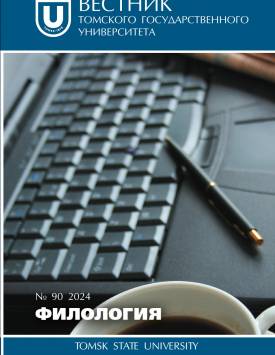Typology of public discourse of the modern Spanish monarchy through the speech acts theory
The article discusses the typology of public speeches of the Spanish monarch Philip VI through the theory of speech acts. Philip VI’s speeches, being a sample of discourse of power, can be considered a special speech genre that combines properties of political and institutional discourse, as well as a communicative resource necessary for transmitting certain ideas and managing public consciousness. The public discourse of Philip VI has its own typology, which correlates with the components of the pragmatic framework (characteristics of the target audience, the subject of the message and the socio-political context), and also demonstrates certain configurations of speech acts taking into account linguistic forms and speech formulas that form illocutionary frame which is determined by the speaker’s communicative task and intention. We propose to divide the corpus of Philip VI’s speeches into two groups (according to the topics and the target audience - national or international), each of which has its own varieties. The specific division of public communication of the state leader is based on Mikhail Bakhtin’s understanding of the genre, reflecting the specifics of the conditions and the purpose of communication at the content, style and composition levels. The study has shown that, on the one hand, the public speeches of the Spanish monarch are regulated by historical tradition and meet the standard of communication with the target audience, and, on the other hand, they are completely subordinate to the nature of the event, which also determines their genre and configuration of the speech acts presented in them. In accordance with Searle and Austin’s speech acts theory, it has been revealed that the institutional political discourse of the Spanish monarch has a bright intentional orientation, which involves a certain set of lexical (verbs, modal words, periphrastic constructions), syntactic (word order) and grammatical (verb mood) means in each discursive type. The main speech acts, within which the speaker’s beliefs and attitudes are broadcast, are constative and evidential representatives, which serve as the illocutionary framework for all types of royal speeches; directives that reveal the greatest variety of combinations with other intentions and forms of expression; commissives, almost always implemented in an indirect form as representative constatives; expressives, vividly presented in speeches on special occasions, and isolated cases of a declarative in an indirect form. It has been found that the choice of a speech act fully correlates with the functions of speech genres and the communicative task of the speaker. The authors declare no conflicts of interests.
Keywords
discourse of power, status-oriented discourse, Spanish monarchy, discourse typology, public speech, speech strategiesAuthors
| Name | Organization | |
| Raevskaya Marina M. | Lomonosov Moscow State University | mraevskaya@gmail.com |
| Selivanova Irina V. | National Research University Higher School of Economics | iselivanova@hse.ru |
References

Typology of public discourse of the modern Spanish monarchy through the speech acts theory | Vestnik Tomskogo gosudarstvennogo universiteta. Filologiya – Tomsk State University Journal of Philology. 2024. № 90. DOI: 10.17223/19986645/90/6
